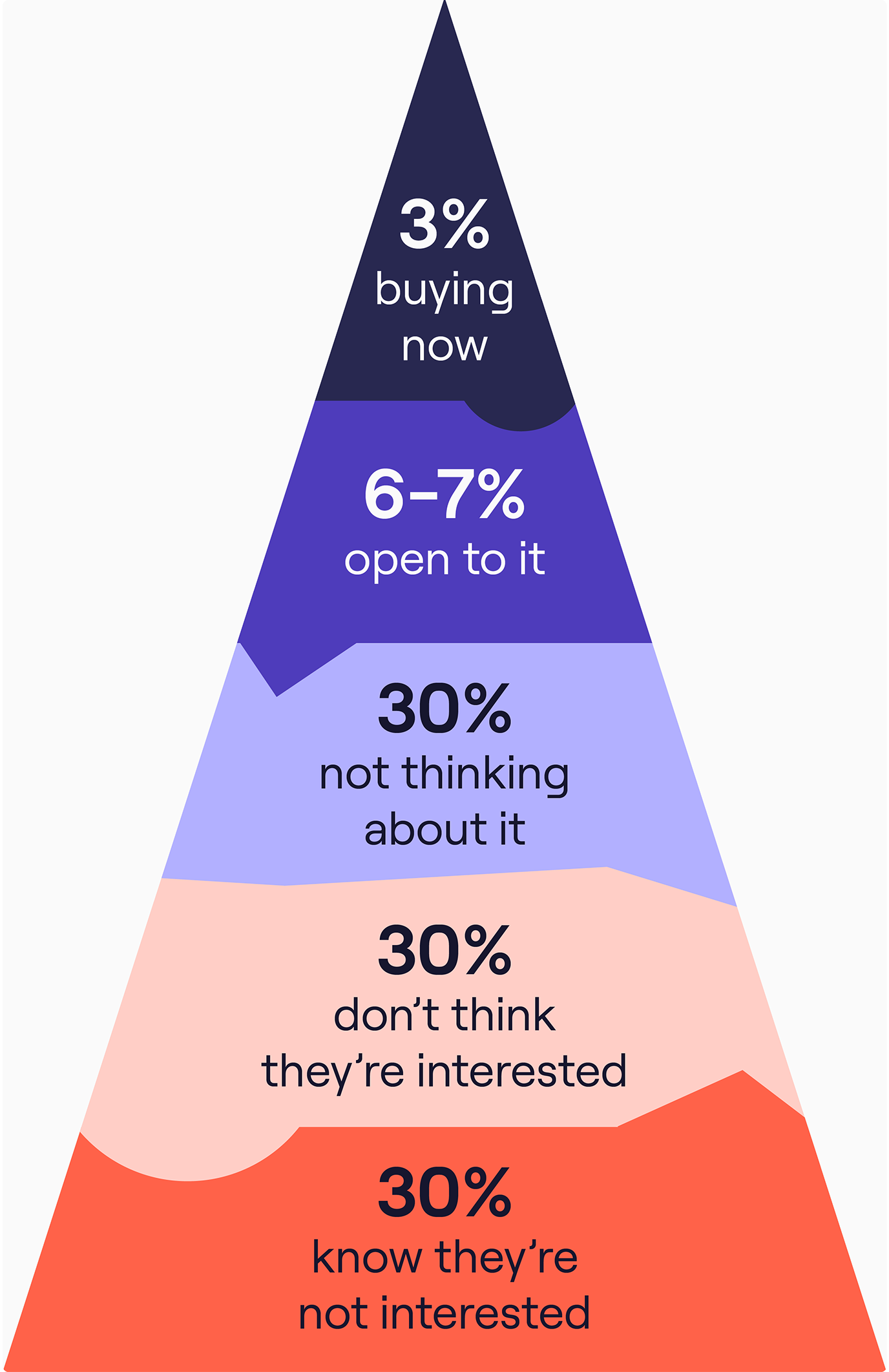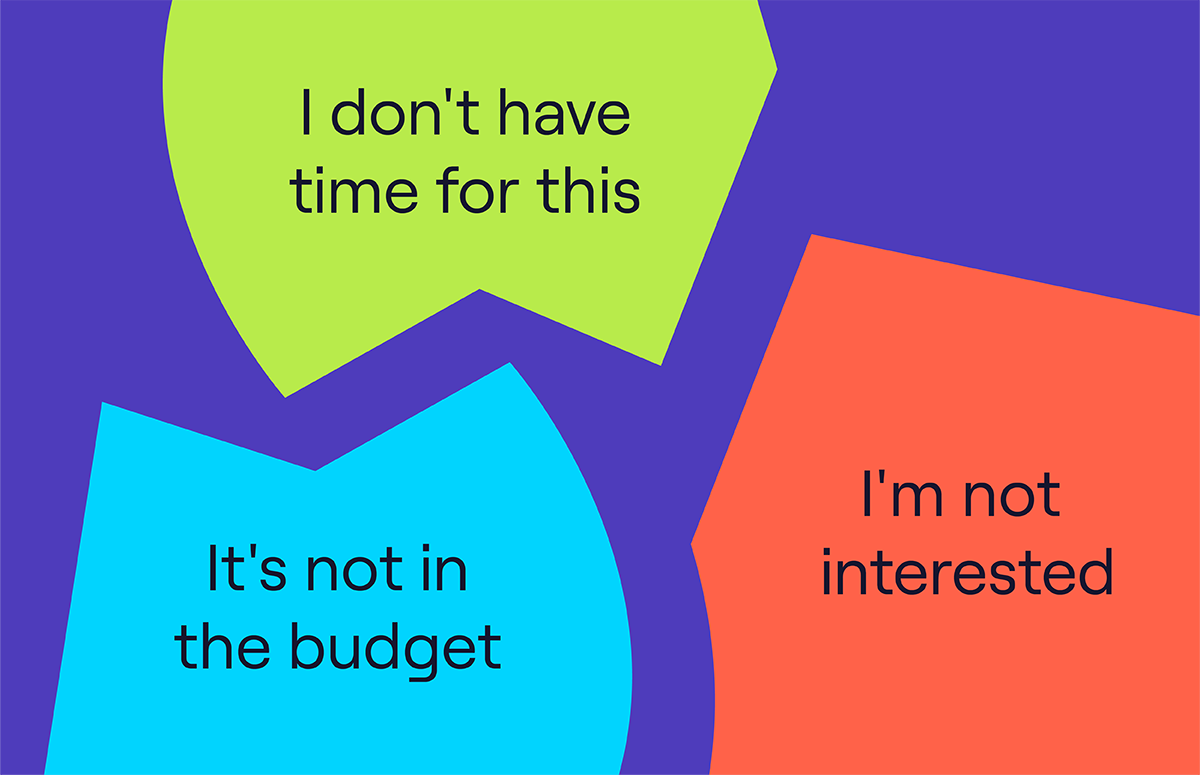Tired of Cold Call Rejection? Top Tips to Handle Rebuttals
Cold call rejection rebuttal tips:
Getting 10, 20, or even 100 daily cold call rejections can be exhausting, no matter how long you’ve been in the game. Unfortunately, it’s an inevitable part of the work.
Some leads won’t answer the phone. Others will hang up on you.
The most taxing calls are the ones where you feel a little hopeful.
Fortunately, how you handle rejection in sales is within your control.
We asked sales expert Ryan Reisert to share his advice and insights on how to bounce back from rejections and even turn them into wins.
👇 Read on for his top tips!
1. Reframe how you view cold call rejection
A sales rejection isn’t really rejection - it’s information.
This is something Ryan told us.
But what does he mean by it?
He means that you shouldn’t take no for an answer. He explained that it’s essential that sales development reps recognise when they’re wasting their time with someone who simply isn’t interested and won’t ever be.
“Part of the role of an SDR is to go out on a fact-finding mission, learn about the prospect’s pain points and see if they might have a solution to help.”
In other words, an SDR is a scout venturing ahead of the group to look for routes worth taking.
Ryan continues:
“So cold call rejection, in reality, is data to inform you on their situation and circumstances at that moment.”
“It isn’t permanent. Things change. You can follow up another day. Sometimes, it’s just an issue of timing.”
For example, let’s say you call your prospect on a busy Monday afternoon.
They don’t know who you are, and you’ve interrupted them in a flow - they’re busy preparing for a big meeting.
They might tell you they’re not interested in speaking to you or too busy to talk.
But that doesn’t mean they wouldn’t want to hear what you have to say under less pressured circumstances.
Your window to ask questions is short. Ryan advises gathering as much information as possible about why they might reject you.
“Try to understand it. If they tell you ‘it’s just not for us’, then ask questions like:
- Is it just not for you right now?
- Do you have an alternative solution?
- Is this something that simply isn’t on your radar ever?”
“And from this, you can understand how to process the sales rejection and what is holding them back. Maybe you can send them some follow-up information. Some might engage. They visit the website, now [they’ve accepted cookies], they get ads so that they might come back someday.”
Knowledge is power, after all. The more you can understand where your prospects’ heads are at, the easier it is to follow up with them later, hopefully when it’s more convenient to talk.
💡You might also be interested in our article on the best time to cold call to reduce sales rejections.
2. Consider the buyer’s pyramid
Another helpful way to reframe how to process rejection as a cold caller is to put your calls in the context of Chet Holmes’ Buyer’s Pyramid.
Ryan explained the framework more thoroughly. It shows what percentage of your audience is likely to be buying at any given moment.
- Only 3% of the people on your call list are buying now.
- About 7% are open to buying.
- Roughly 30% are not thinking about it.
- The other 30% don’t think they’re interested.
- And the final 30% know they’re not interested.

“So by that logic, 6/10 of your cold calls will almost definitely end in rejection - just by simple statistics.”
“Only 1 in 10 are in that ‘buying now’ or ‘open to it’ category. And some of them may have already been researching a competitor.”
“Your winning zone is the 30% that aren’t thinking about it yet. These are the prospects you are most likely to influence.”
“Most people starting cold calling will fall into the 3-10% conversion rate range.”
You can see how understanding the math allows you to visualise what’s realistic regarding success.
Ryan said:
“Most SDRs aren’t getting as many rejections as they should be. They don’t make enough dials and give up after one or two cold call rejections because it feels tough.”
“But if you want to be a successful SDR, you have to be willing to make the nine calls where you get rejected to get the tenth call where you book the meeting.”
3. Prepare, prepare, prepare
We asked Ryan if you could do any sales call prep work before the call to reduce your chances of cold call rejection.
He told us:
“Of course, skill matters to an extent. Having an effective cold calling framework behind you and the ability to manage a conversation confidently can help.”
“But even if you are as prepared as you can be. You’ve practised, know your script inside and out, and prepared sales rejection responses for as much as you can think of…”
“You will still get rejections.”
“Because it isn’t about you. If your prospect isn’t ready to talk yet, there isn’t much you can do at that time.”
“So accept it, move on to your next call, and see how you can follow up with this prospect in future.”
To a certain extent, cold calling is a numbers game. Understand the math and try not to take the rejections personally.
Handling cold call rejection is a challenge. Here are a few resources to help you prepare your responses:
- Cold calling scripts
- Cold calling opening lines
- Cold calling examples
- Cold call objections and responses
- Cold email templates
- Voicemail scripts
4. Put the prospect first
Think about what happens when you enter a physical store. The shop assistant comes over to ask if you need help finding anything.
You reply, ‘No thanks, I’m just browsing.’
But then the shop assistant tries to change your mind:
‘Are you sure? Let me tell you more about how great these products are. Why would you come into the store if you weren’t going to buy something?’
Turning on your heels and leaving the shop wouldn’t take long!
Reacting this way on the phone is likely to have a similar effect. Your prospect switches off, their guard comes up, and you’re quickly brushed off.
Ryan explains:
“Many SDRs are told to operate this way, book meetings at any cost, and try to change your prospects’ minds.”
“But generally, people don’t respond well to being told what to do or feeling forced into making a decision.”
“Try to have empathy; I’m a human being, and you’re a human being. We don’t know each other, and I may have interrupted you in the middle of something. Try to put yourself in their shoes.”
You’re likelier to make a good impression on your prospects if you’re honest.
Maybe you realise your solution won’t solve the problem they’re facing. But you do know another SDR who works with an alternative that might.
Offering that information is likely to do much more for your reputation than forcing your pitch down their throat.
5. Don’t take offence
If Alexander Hamilton hadn’t taken so much offence from Aaron Burr’s insults, he may not have died in a duel.
Of course, taking offence after a cold call rejection won’t lead to such violent ends, but it will make you stew in resentment, thus halting your forward progress.
Don’t obsess over thoughts like this:
“But he needs our product so badly! How can he not see it!”
Understand:
“Most prospects are already wary of salespeople calling and have been conditioned to avoid them.”
Noah Kagan, author of Million Dollar Weekend, offers a silly yet effective exercise to handle sales rejection: The Coffee Challenge.
Here’s how to do it.
Go to a cafe and ask the barista for a discount on whatever you ordered. And do it with sincerity. No laughing!
You’ll feel incredibly uncomfortable while asking, but when they inevitably say no, you’ll walk away unscathed, having built up your capacity for the discomfort of rejection.
And if that soft rejection doesn’t help you can check out our article on how to get over the fear of cold calling.
6. Track and review sales calls
Reviewing unsuccessful cold call recordings turns those rejections into learning experiences, like a footballer re-watching their last match.
You can identify where the call went wrong, allowing you to improve next time. This makes cold call rejections feel like they have a purpose; they’re rungs on the latter towards mastery.
Tracking your cold calls and data points, such as the number of rejections, booked meetings, and conversion rate, will also help you feel better about rejections, especially if you’re having a bad day.
Ryan recommends checking past cold calling stats as a quick way to pick yourself up after a bad start to the cold call block:
“Some days, you’ll have more sales rejections than others, but have a look at your stats across the month. They generally normalise over time.”
“If you have a hard day but only had six conversations, maybe those were the 6/10 that were never going to be interested.”
“Make some more calls; the next few might be better! You have to hang on for the layup. If you let the first ten get to you, you might give up, but stick to the process. The numbers usually work out.”
Starting a cold call block with 20 rejections can make the task feel hopeless. We respond emotionally first before logically examining the situation.
However, a quick scan of your cold call report might awaken the rational part of your brain with the historical fact that, on average, your cold call success rate is one for every 21 cold calls you make.
7. Follow up on conversations
After a cold call rejection, the game isn’t over. The lead can still become a customer down the line.
Especially if the rejection was any of these:
- I’m too busy.
- We don’t have the budget.
- We already have a solution for this.
In those cases, keep nurturing the lead with valuable content and follow up with another call in 2-3 months.
By then, the lead’s workload, budget, and satisfaction with their current provider might have all changed.
Even if everything has remained the same on their end, they might be more open to a conversation with you for any of these reasons:
- They like the content you’ve been sending them.
- You are no longer a stranger.
- They’re just in a chatty mood.
When you treat cold call rejection as the first step in a relationship-building process, it’ll be easier to swallow.
8. Leverage soft rejections
Soft rejections open the door for future outreach; sometimes, they almost even feel like they’re inviting it.
It’s when a lead said something like the following:
"Hmmm, interesting, ya know what, now’s not a good time, but it sounds like a useful tool.”
In this example, the lead has complimented the product.
They’ve used the word “now,” implying that they might be interested at a better time. They don’t say to call back in a month, but they certainly mean it.
Dig into these rejections.
A rebuttal example here is to say you understand, then ask for permission to ask a few more questions—as Ryan said, to get information that’ll help you with your next outreach.
- “Just out of curiosity, what did you like about the tool?”
- “Is there a specific time when you review new tools?”
Gather the intel, then make an automated reminder in your CRM to reach back out in a month, maybe even less if the rejection was warm butter soft.
In the meantime, keep building the relationship and showing your value as a problem solver and industry expert:
“If you can offer your prospect value, they’ll see you care about helping them. They’re far more likely to remember you and want to work with you in future if their circumstances change.”
Too many salespeople give up after soft rejections. Don’t be one of them. These can often end up being easy sales later on.
9. Accept the rejection
Want to stay in the good graces of your lead while protecting yourself from gut-wrenching self-pity?
Accept the rejection, much like the Buddhist monk accepts a toothache.
Not to get too spiritual on you here… but once accepted, the experience loses its power to cause you distress.
“Happiness can exist only in acceptance.” - George Orwell.
Additionally, playing it cool signals to the lead that you respect their time and are high value with plenty of other leads to choose from.
This perceived value increases the likelihood that they’re open to speaking with you later on.
So, keep Ryan’s words in mind when you feel like pouting or pushing:
“Your prospect hasn’t requested this phone call, and you’re calling them unannounced. So respect their decision to not speak to you if it’s not a good time.”
And that’s how to process sales rejection.
10. Look to your mentor
Humans learn primarily through imitation.
When someone sees someone do something they admire, they unconsciously copy it.
This is one of the reasons why it’s so valuable to have a good sales manager. Their character, tactics, and approaches to difficult sales situations inevitably rub off on you.
Of course, the amount of their brilliance you absorb depends on how much time you spend with them, so strive to do the following activities as much as possible:
- Mock cold call sessions.
- Sales call shadowing.
- One-on-one conversation.
Concerning cold call rejection, ask them how they handle slumps and the doldrums of constant rejection.
They may have unique tactics and rebuttal examples you could try out.
And more than that, they’ll likely provide you with the support and encouragement you need to push through your paralysis, hopefully in the form of stories about their own experiences with rejection and objection handling.
Sometimes, just hearing that someone we look up to has gone through the same thing is enough to relieve the discomfort.
11. Take a step back
Let’s say you made 200 calls, 100 people answered, and they all flat-out rejected you.
It might be time to review your list of leads and your approach to cold calling. Something is off.
Ryan echoes the sentiment:
“Review the suitability of your prospects for your product or service and adjust your message where necessary.”
After ensuring your list contains high-quality leads who fit your ideal customer profile, review the part of your cold call script where calls usually go awry.
That might be the opening, the value proposition, or the close.
Figure out one to two ways to tweak the script, preferably with the sharp eye of a peer or manager.
Then, if you feel you need it, take a real step back.
Take a day off from cold calling.
Tomorrow, you can try out your new approach. Today, catch up on social selling, do some email outreach, or just go and do something fun to recharge. Tomorrow is another day. The cold leads aren’t going anywhere.
Cold call rejection: closing thoughts
The greatest lesson AppSumo founder Noah Kagan learned from his father was the power of leaning into rejection.
His father, a door-to-door salesperson, used to set a goal of getting 100 sales rejections per day. He knew how to render rejection powerless.
To succeed in business and B2B sales, one has to have this mindset. You must see it not as a failure but as a source of motivation, a sign of your resilience, and a chance to improve your craft.
“Yes” will come, but only after many “nos”.




